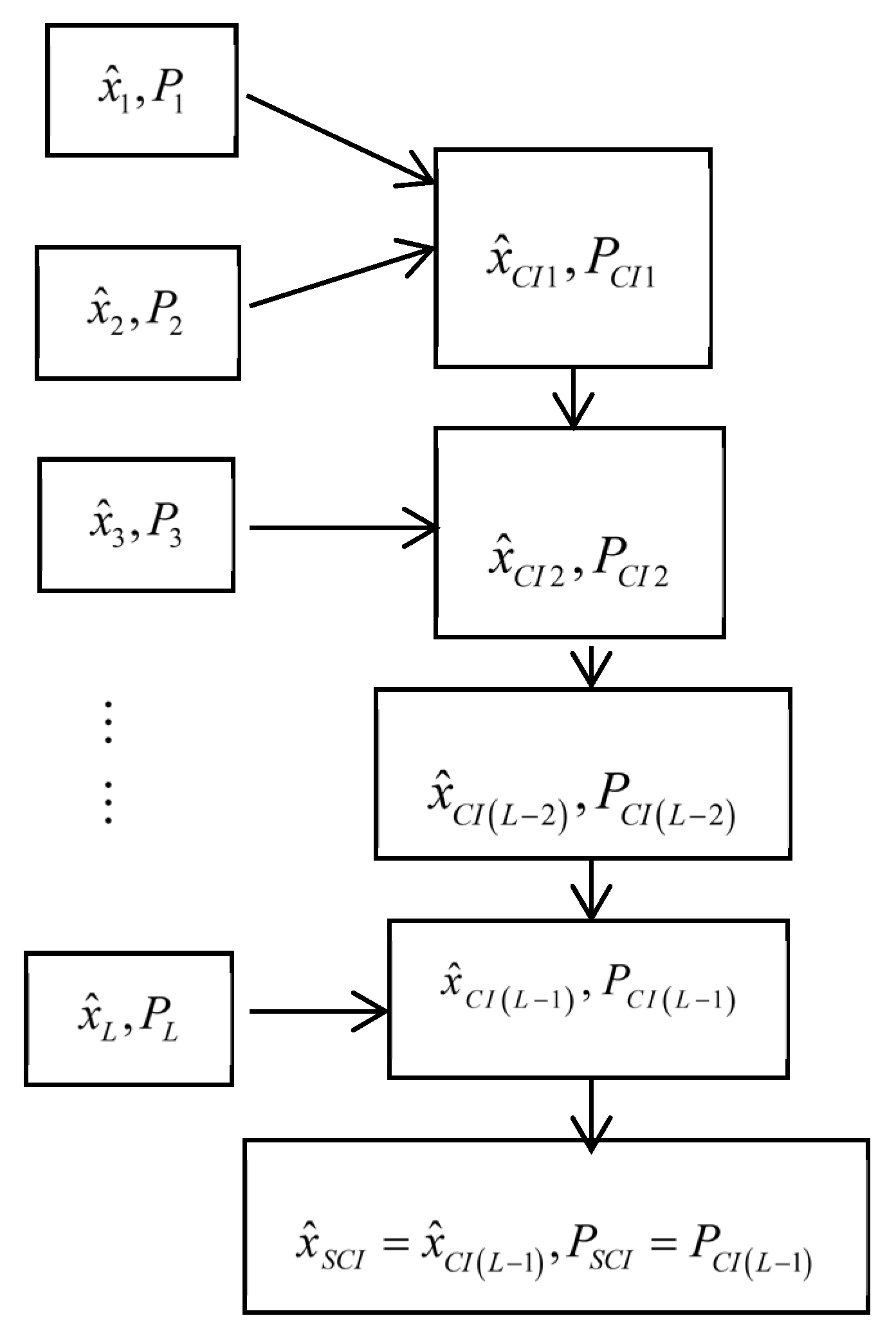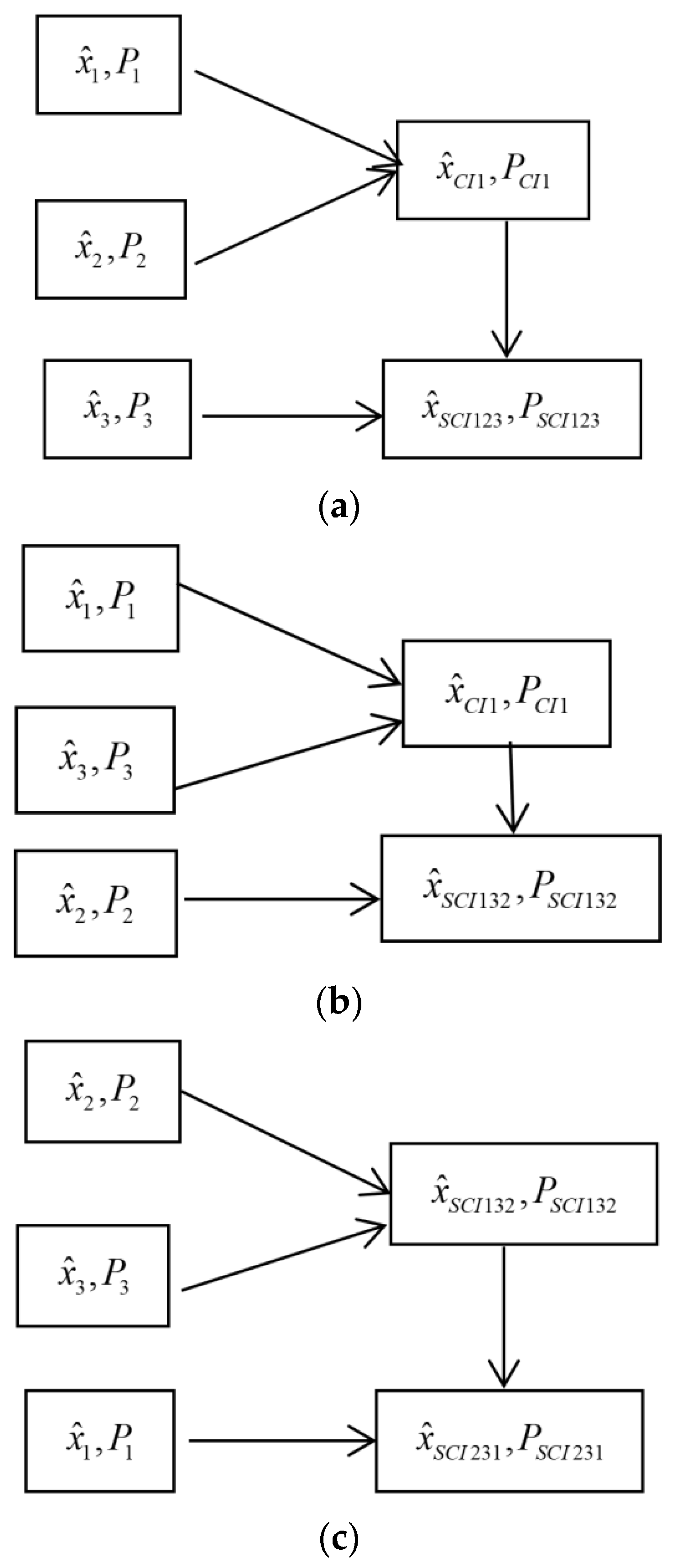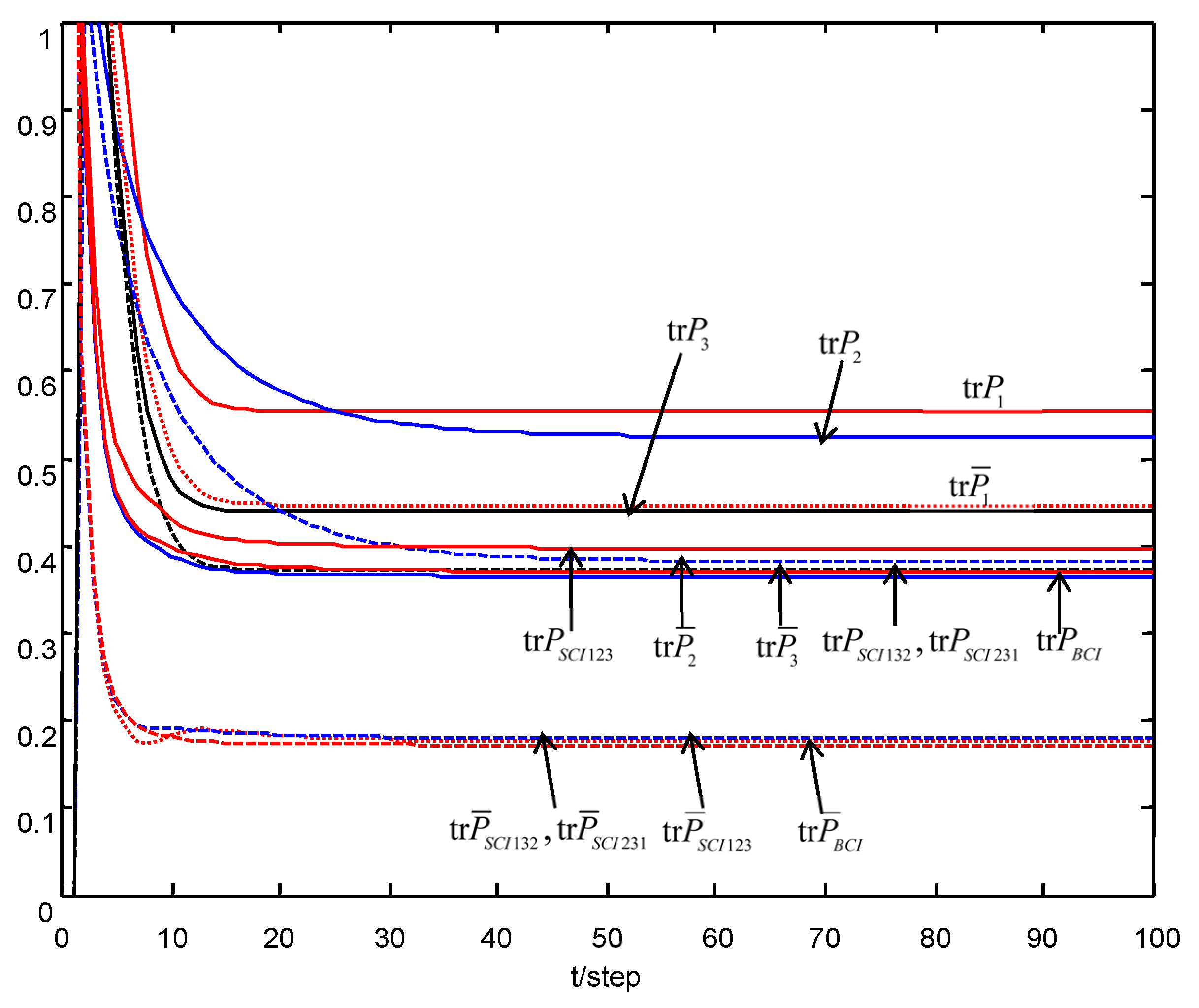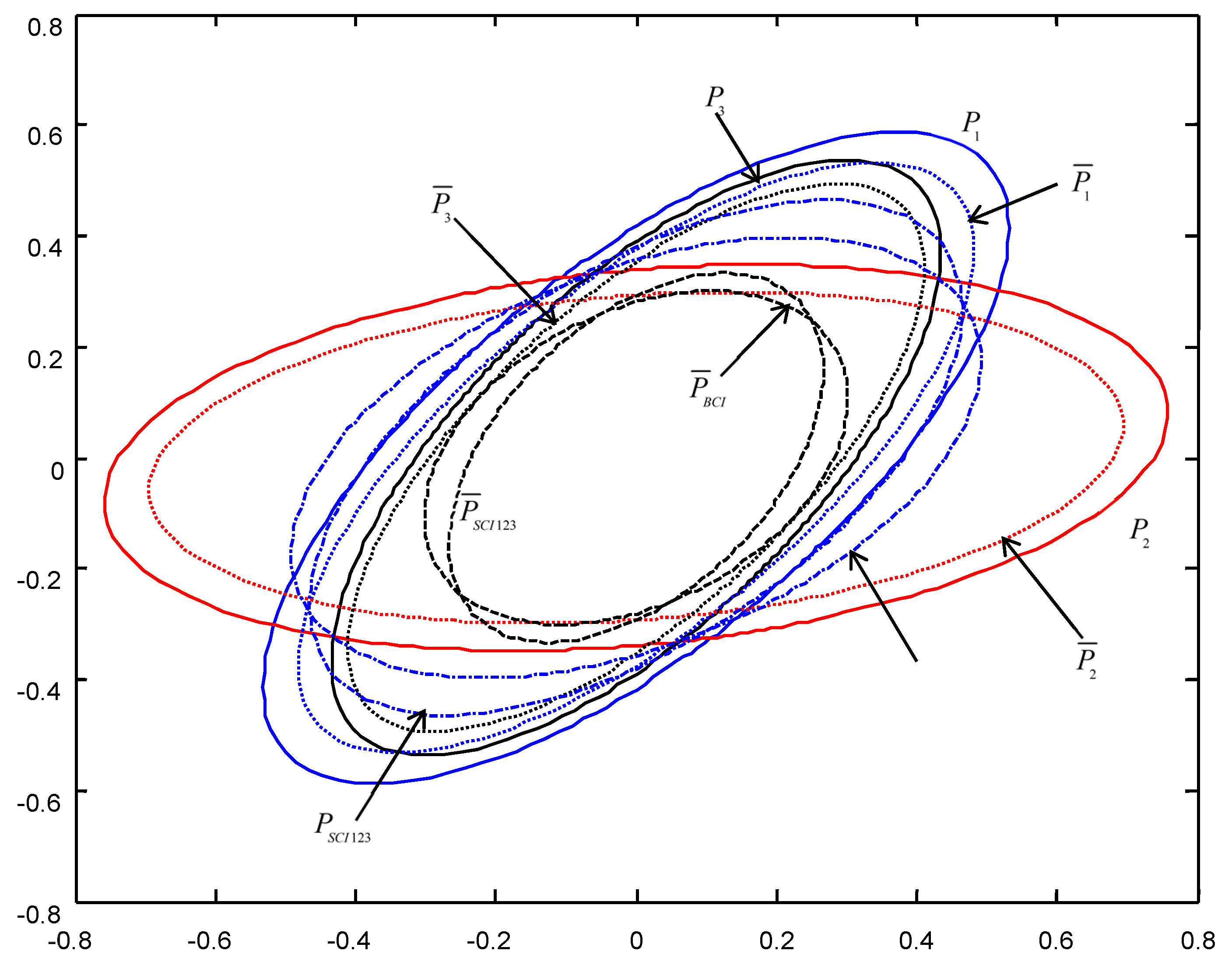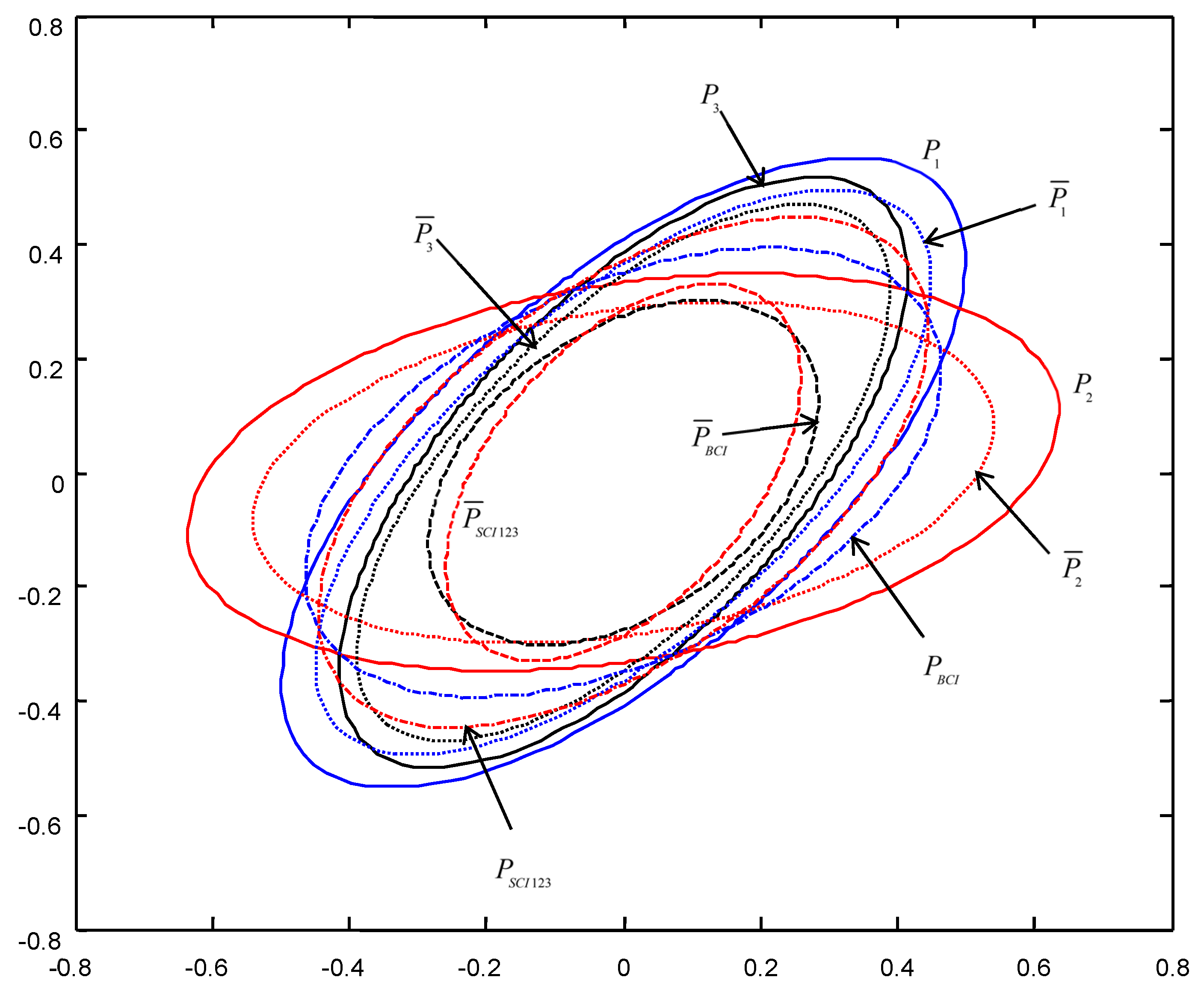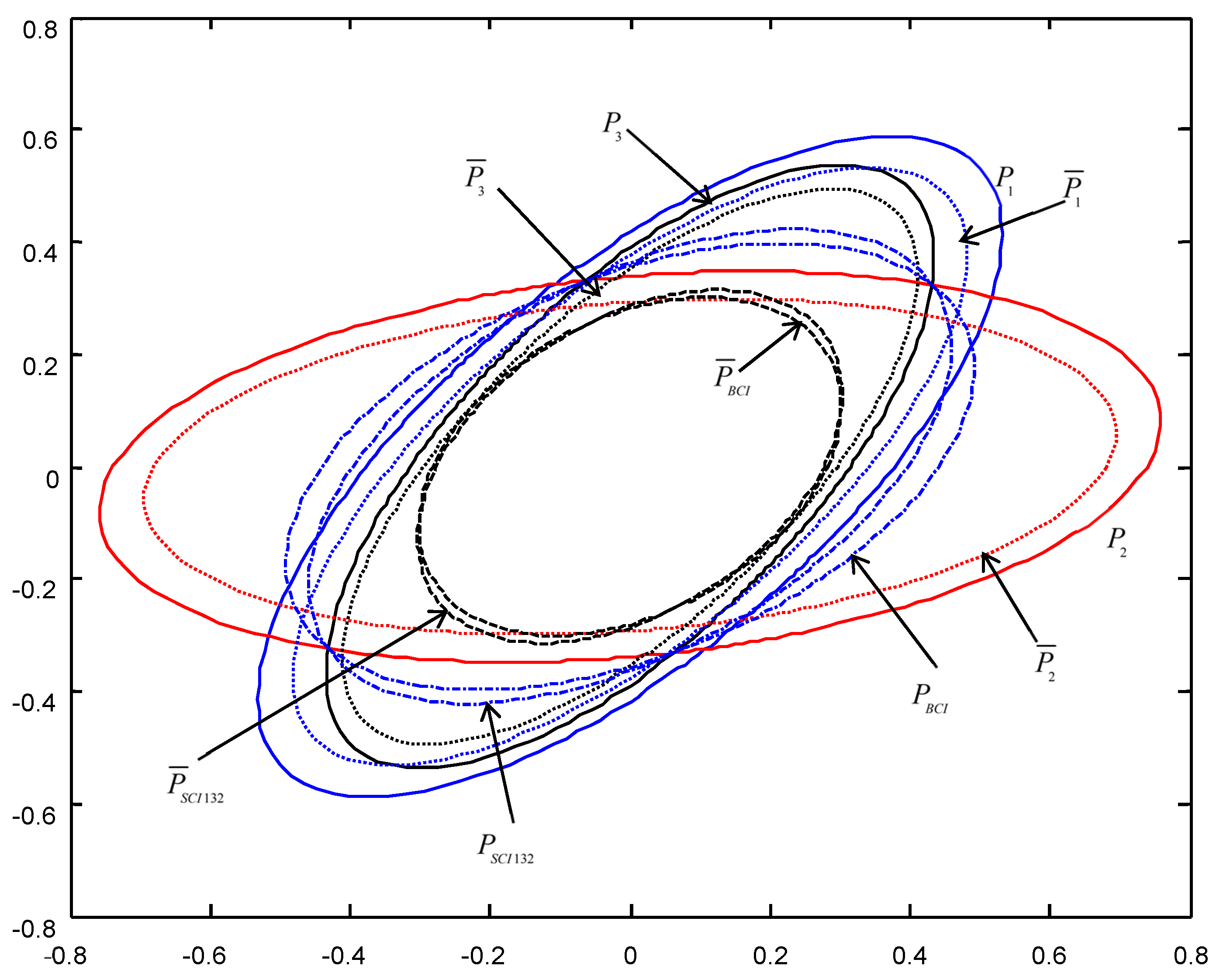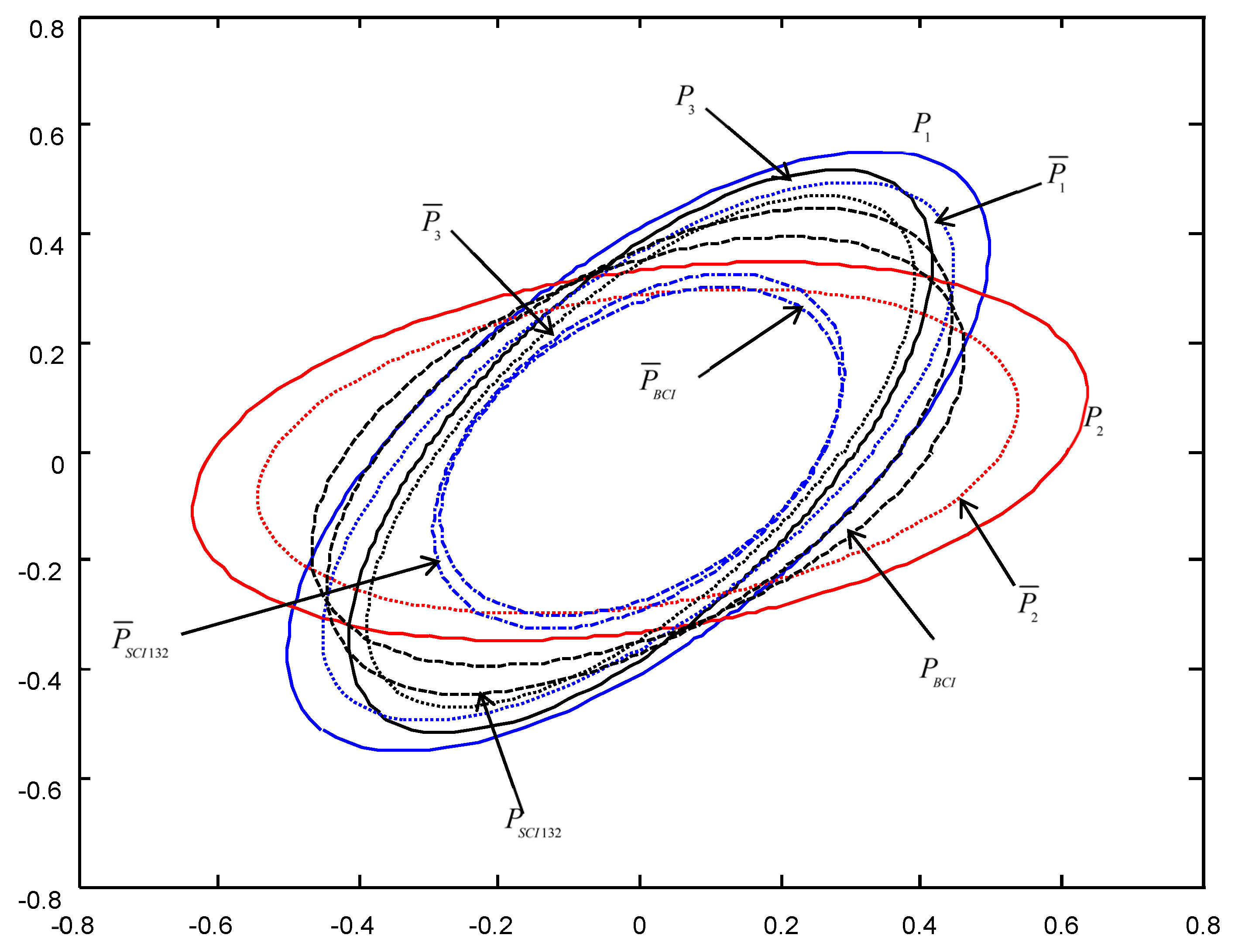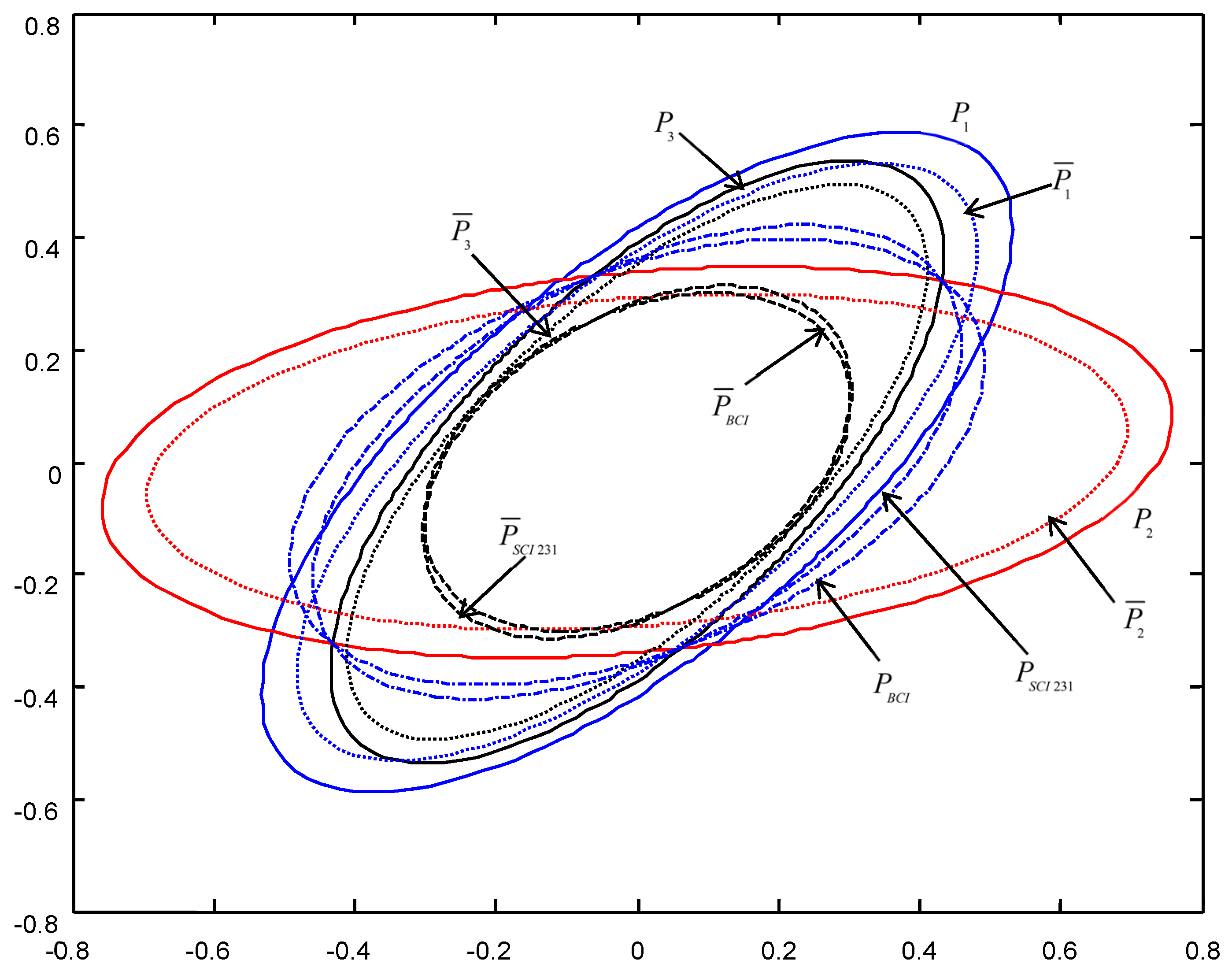1. Introduction
The multisensor information fusion Kalman filtering has wide applications in many high-technology fields, such as advanced manufacturing systems, mechanical industrial robots, unmanned aircraft vehicles, tracking, signal processing, remaining useful life prediction of rolling element bearings [
1,
2,
3], improved tracking and docking of industrial mobile robots [
4,
5,
6,
7], and so on. Rolling bearings are the key components of rotating machinery, thus, the prediction of remaining useful life (RUL) is vital in condition-based maintenance (CBM). Reference 1 proposes a new method for RUL predictions of bearings based on time-varying Kalman filter, which can automatically match different degradation stages of bearings and effectively realize the prediction of RUL. Industrial mobile robots are widely used in advanced manufacturing technology systems; ref. [
2] used the unscented Kalman filter to improved tracking and docking of industrial mobile robots vision-based kinematics calibration.
The basic assumption for classical Kalman filtering is that the model parameters and noise variances are exactly known, but in many practical applications, such assumption doesn’t always hold. In the presence of these uncertainties, the Kalman filters may not be robust against uncertainties, or may be divergent [
8], or the performance of the filters is degraded. In order to solve the filtering problems for uncertain systems, in recent years several results have been derived on the design of various robust Kalman filters. The so-called robust Kalman filtering problem is to find a Kalman filter whose actual filtering error variances, or their traces, are guaranteed to have a minimal or less-conservative upper bound for all admissible uncertainties. There are basically two approaches to solve this problem for the systems with uncertainties of model parameters: one is the Riccati equation approach [
8,
9,
10,
11]; the other is the linear matrix inequality (LMI) approach [
8,
12,
13].
The uncertain systems exist widely in control engineering and signal processing. So far, these robust Kalman approaches are only suitable to the systems with the uncertainty of model parameters, while the uncertainties of noise variances are seldom considered. Many results are limited to design the robust Kalman filters for single sensor systems, while the multisensor fusion robust Kalman filters are seldom proposed [
14,
15,
16,
17], and the robustness analysis problem was not solved.
The multisensor data fusion problem is to find a fused state estimator based on the local sensor measurement information or the local state estimators such that its accuracy is higher than that of each local state estimator [
18,
19,
20]. There exist two kinds of fusion methods, which are called the centralized and distributed fusion methods depending on whether raw data are used directly for fusion or not [
19]. For the centralized fusion method, all the measurement data from local sensors are carried to the fusion center which can give the global optimal fusion estimate, but its disadvantage is to require a large computation burden. The distributed fusion method can give the globally optimal or suboptimal state estimation by combing the local state estimators [
20,
21,
22], whose advantages are that it can reduce the computation burden and can realize fault detection and isolation more conveniently. Under the unbiased linear minimum variance rule (ULMV), there are three distributed optimal fusion rules weighted by matrices, diagonal matrices, and scalars, respectively, which were presented in [
20,
23].
It is well known that to compute the optimal weights requires knowing the cross-covariance among the local Kalman filtering errors [
20,
21,
22,
23]; however, in many practical applications, the variances and cross-covariances of the local filtering errors are unknown or uncertain, or the computation of the cross-covariances is very complex and difficult [
21,
24]. In order to overcome the above limitation, the covariance intersection (CI) fusion method has been presented in [
25,
26,
27,
28,
29] and has been widely applied in many fields; for example, the simultaneous localization and mapping (SLAM) [
29], remote sensing [
30], rocket tracking [
31], spacecraft estimation [
32], vehicle localization [
33] and so on. The CI fuser is obtained by the convex combination of the local estimators, and it has the advantages that the fused estimation problems can be solved for multisensor systems with unknown variances and cross-covariances of local filtering errors, and the computation of the cross-covariances is completely avoided. However, its disadvantage is that the conservative upper bounds of the unknown local filtering error variances are assumed to be known, i.e., the consistent estimation problem of the unknown local filtering error variances was not solved.
Based on the batch processing method, the batch covariance intersection (BCI) fusion Kalman filter with exactly known model parameters and noise variances is presented [
22]; this needs to solve the high-dimensional nonlinear optimization problem, so that a larger computation burden and higher complexity are required. In order to reduce the computation burden and complexity by the sequential procession method, a sequential covariance intersection (SCI) fusion Kalman filter is presented in [
34] for multisensor systems with noise variances to be known exactly.
In this paper, we will focus on the covariance intersection (CI) fused robust Kalman filtering for multisensor systems with uncertainties of noise variances. A robust CI fusion Kalman filtering theory and methodology are presented. Compared with references [
22,
25,
26,
27,
28,
29,
34], the main contributions are as follows:
In
Section 2 and
Section 3, a new methodology for designing the robust local and CI fused Kalman filters is presented for multisensor time-varying systems with uncertain noise variances, according to the minimax robust estimation rule [
35,
36]. Its basic principle is that based on the worst-case conservative system with the conservative upper bound of noise variances, applying the ULMV optimal estimation rule, the conservative local and CI fused Kalman filters with unavailable conservative measurements are obtained, and then replacing the conservative measurements with the actual measurements yields the robust local and CI fused Kalman filters. The classical optimal Kalman filtering methodology [
22,
34] is developed. The disadvantage of the original CI fusion methodology [
25,
26,
27,
28,
29] is overcome where the conservative upper bounds of the local filtering error variances are assumed to be known. Hence the robust local Kalman filters are presented, which provide the conservative upper bounds of the local filtering error variances;
In
Section 3, the robust time-varying BCI and SCI fused Kalman filters with uncertain noise variances are presented. The steady-state optimal local, BCI and SCI fused Kalman filters [
22,
34] with exactly known noise variances are developed;
In the process of proving Theorems 1 and 3, a Lyapunov equation method for the robustness analysis is presented by which the robustness of the local and CI fused Kalman filters is proved. Its basic principle is that the problem of proving the robustness is converted into that of deciding the positive-definiteness of the solution of a Lyapunov equation;
In
Section 4, the concept of robust accuracy with respect to uncertainties of noise variances is presented, and the robust accuracy relations among the local, BCI and SCI fused Kalman filters with exactly known noised variances [
22,
34] are extended. The concept of robustness with respect to uncertain noise variances is presented, and the concept of consistency [
25,
26] is extended;
In
Section 5, for the multisensor time-invariant system with uncertain noise variances, the robust steady-state local, BCI and SCI fusion Kalman filters are also presented by replacing time-varying gains, variances and cross-covariances with their limits, respectively;
Using lemma 1–3, in Theorem 7, the convergence in a realization of the local and fused time-varying and steady-state robust Kalman filters is proved by the dynamic error system analysis (DESA) method and the dynamic variance error system analysis (DVESA) method. To the best of our knowledge, it is presented for the first time;
In
Section 7, simulation 1 gives the geometric interpretation of the robust accuracy relations based on the variance ellipses and a Monte Carlo simulation example shows the correctness of the proposed robust accuracy relations and gives the sensitivity analysis of the robust SCI fuser.
The remainder of this paper is organized as follows: In
Section 2, we derive the local robust time-varying Kalman filter and prove its robustness.
Section 3 gives the BCI and SCI fusion robust time-varying Kalman filters and the proof of their robustness. The accuracy analysis of the local and fused Kalman filters is presented in
Section 4.
Section 5 gives the robust local and fused steady-state Kalman filters and their convergence. The sensitivity problem is given in
Section 6.
Section 7 gives a Monte Carlo simulation example. The conclusions are given in
Section 8. The frequently used notations in the paper are shown in
Table 1.
2. Local Robust Time-Varying Kalman Filters
Consider the following multisensor uncertain time-varying system with uncertainties of noise variances
where
is the state,
is the number of sensors,
is the measurement of the
subsystem,
is the input noise and
is the measurement noise of the
sensor.
,
and
are known time-varying matrices with appropriate dimensions.
Assumption 1. andare uncorrelated white noises with zeros mean and unknown uncertain true variancesand,
respectively.
Assumption 2. andare known conservative upper bounds ofand,
respectively, i.e., Assumption 3. The initial stateis independent ofand,
and has mean valueand unknown uncertain true variancewhich satisfieswhere is a known conservative upper bound of .
Based on the
sensor, for the worst-case conservative multisensor system (1) and (2) with the known conservative upper bounds
and
of noise variances, the conservative local optimal time-varying Kalman filters are given by [
20]
From (1) and (6), the actual filtering errors are
From (15), according to Assumptions 1–3, and noting that
and
are uncorrelated with
, the actual filtering error variance and cross-covariances are given by the Lyapunov equations
with the initial values
and
.
Theorem 1. For multisensor uncertain system (1) and (2) with Assumptions 1–3, the actual local Kalman filters (6) is robust in the sense that for all admissible variancesandsatisfying (4) andfor arbitrary time, we have
and are the minimal upper bounds of .
Hence, they are called the robust local Kalman filters. Proof. Defining
, subtracting (16) from (12) yields the Lyapunov equations
Applying (4) yields that . From (5), we have . Hence from (18), we have . Applying the mathematical induction method yields , for all time , i.e., the inequalities (17) hold. If is another upper bound, then for all admissible and , we have . Taking , from (12) and (16), we have . This means that is the minimal upper bounds of . The proof is completed. □
Remark 1. The robustness (17) is different from the consistency or non-divergent estimation [23]. The robustness means that the inequality (17) holds for all admissible uncertainandsatisfying (4), while the consistency means that for a fixedand, the inequality (17) holds. 4. Accuracy Analysis
From (53), we can see that is the upper bound of the unknown actual fused variances for all possible and all admissible unknown satisfying (16), so that can be viewed as the global accuracy of the SCI fuser. From (46), we see that is independent of actual variances and cross-covariances . So that the global accuracy of the SCI fuser has the robustness with respect to uncertain and . From (16), we see that the uncertainties of and are yielded by the uncertainties of and satisfying (4).
Definition 1. The robustness with respect to uncertainties of noise variances of a Kalman filter is defined as its actual filtering error variances or their traces yielded by all admissible uncertainties of noise variances, which are guaranteed to have a minimal or less-conservative upper bound and this upper bound is independent of uncertainties of noise variances. The Kalman filter with robustness is called to be robust.
Definition 2. The robust accuracy of a robust Kalman filter is defined as the trace of a minimal or less-conservative upper bound of its actual filtering error variances, while its actual accuracy is defined as the trace of its actual filtering error variance.
Theorem 6. For multisensor uncertain system (1) and (2) with Assumptions 1–3, the actual and robust accuracies of the local, BCI and SCI fused time-varying Kalman filters have the relations
Proof. Taking the trace operations for (17), (29) and (53) yields (54) and (55). In (25), taking and yields , Hence, minimizing with constraints , , we have , , i.e., (56) holds. From (45) and (46), the SCI fuser is equivalent to a BCI fuser with , applying (25) yields (57).
The robust accuracy relation (58) can be proved by mathematical induction. For
, from (40)–(44) we have
where
are the actual local Kalman filters, the weight
minimizes the cost function
as
Taking
, we have
, and taking
, we have
, hence for
yields
Similarly, for
, from (40)–(44) we have
From (62) and (63), one can obtain
By the mathematical induction method, assume that for
, the following inequality holds
For
, from (44), we have
From (65) and (66) yields
Noting that , which yields the inequality (58). The proof is completed. □
Remark 5. The accuracy relations (54) and (55) mean that for all admissible uncertainties of variances satisfying (4) and (5), the actual accuracies, of the local or fused time-varying Kalman filter are globally controlled by, therefore the robust accuracyis also called the global accuracy of a robust Kalman filter. The robustness of the local and fused filters means that the robust accuracyis independent of arbitrarily variances satisfying (4) and (5).
Remark 6. From the definition 2, the smaller(or) means the higher robust (or actual) accuracy. From (54)–(58), we conclude that the robust accuracy of the robust SCI fuser is higher than that of each local robust Kalman filter, and the robust accuracy of the BCI fuser is higher than that of the SCI fuser. The actual accuracies of a robust Kalman filter are higher than its robust accuracy for all admissible uncertainties.
Remark 7. Theorem 1 shows thatis the minimal upper bound ofin the matrix inequality sense. Theorem 3 shows thatis the minimal upper bound ofin the trace inequality sense. From (55), (57) and (58) yields that, so thatis a less-conservative upper bound of.
5. Robust Local and Fused Steady-State Kalman Filters
Now we investigate the asymptotic properties of the local and fused robust time-varying Kalman filters, we shall present the corresponding steady-state robust Kalman filters. We shall also rigorously prove the convergence in a realization between the robust time-varying and steady-state Kalman filters, by the DESA method and DVESA method [
37,
38].
Lemma 1 [39]. Consider the following Lyapunov equation withbeing a symmetric matrixwhereandare thematrices,is a stable matrix (i.e., all its eigenvalues are inside the unit circle). If, thenis symmetric and unique, and.
Lemma 2 [38]. Consider the time-varying Lyapunov equationwhere , the output and the input are the matrices, and the matrices and are uniformly asymptotically stable, i.e., there exist constants and such that If is bounded, thenis bounded. If, then, as. Notice thatis called to be bounded, if(constant), for arbitrary.
Lemma 3 [37]. Consider a dynamic error systemwhere,, andis uniformly asymptotically stable. Ifis bounded, thenis bounded. If, then, as.
Theorem 7. For multisensor uncertain time-invariant system (1) and (2) with Assumptions 1–2, where,
,
,
,
andare all the constant matrices. If each subsystem with conservative noise variancesandis completely observable and completely controllable, then the actual local steady-state Kalman filters are given aswhere are the actual measurements, and the initial value can arbitrarily be selected. satisfies the steady-state Riccati equationsand the conservative cross-covariances and the actual cross-covariancessatisfy the steady-state Lyapunov equationswith the definition ,, and we have The actual local steady-state Kalman filters (72) are robust in the sense that for all admissible uncertainties of and satisfying , thenand
is the minimal upper bound of
. They are called the robust local steady-state Kalman filters. Proof. According to the complete observability and complete controllability of each subsystem, we have [
40]
Then from (7), (8) and (11), we have
where
are stable matrices [
40], and
are uniformly asymptotically stable [
40]. When
, taking the limit operations for (6)–(11), (12) and (16), we obtain (72)–(77). From
, the gains
are bounded, which yields the boundedness of the input of the Lyapunov Equation (12). Hence, applying Lemma 2 to (12) yields that
are bounded. Setting
with
, and subtracting (76) from (12) with
and
, and defining
, yields the Lyapunov equations
Applying , the boundedness of , and yields that . Applying Lemma 2 to (83) yields , as , i.e., (78) holds. Similarly, we can prove (79). Taking the limit operation for (17), as , and applying (78) and (79) yields (80). Taking , subtracting (77) from (76), and applying Lemma 1 yields , if is arbitrary other upper bound of for all admissible and satisfying , then we have , which yields that is the minimal. The proof is completed. □
Theorem 8. For multisensor uncertain time-invariant system (1) and (2) with Assumptions 1–2, if each subsystem with conservative noise variancesandis completely observable and completely controllable, then the actual steady-state BCI fusion Kalman filter is given aswhere are given in Theorem 7, and the optimal weighting coefficients are obtained by minimizing the performance index as It has the robustness in the sense that for all admissible uncertainties of and satisfying , we havewhere the actual fused steady-state filtering error covariance is given asand
is the minimal upper bound of
. It is called the robust steady-state BCI fusion Kalman filter. Proof. As , taking the limit operations for (23)–(26) yields (85)–(87). Taking the limit operations for (24) and (26) and applying (78) and (79) yields that , so that taking the limit operations for (26) and (29) yields (88) and (89). The proof is completed. □
Theorem 9. For multisensor uncertain time-invariant system (1) and (2) with Assumptions 1–2, if each subsystem with conservative noise variancesandis completely observable and completely controllable, the actual steady-state SCI fusion Kalman filter is given aswhere the weighting coefficients can be computed recursively byand it is robust in the sense that for all admissible uncertaintiesandsatisfying , we have It is called the robust steady-state SCI fusion Kalman filter.
Proof. As , taking the limit operations for (45)–(47), and (53) yields (90)–(92), and (96). From (48)–(50), we have (93)–(95). The proof is completed. □
Theorem 10. Under the conditions of Theorem 7, if the measurement data ofare bounded, then the robust local time-varying and steady-state Kalman filtersandgiven by (6) and (72) have each other the convergence in a realization, such that Proof. Setting
,
in (6), applying (82) yields
,
, as
. Subtracting (72) from (6), and defining
, we have
with
. Noting that
is uniformly asymptotically stable, and
is bounded, applying Lemma 3 to (6) yields the boundedness of
. Hence, we have
. Applying Lemma 3 to (98), noting that
is a stable matrix, so it is also uniformly asymptotically stable, hence
, i.e., the convergence (97) holds. The proof is completed. □
Theorem 11. Under the conditions of Theorem 10, the robust time-varying and steady-state SCI fusersandhave each other the convergence in a realization, such that Proof. From (87), the minimal value point
of
is obtained by solving nonlinear equations
According to the existence theorem [
36] of implicit function, in a sufficiently small neighborhood of the point
with the definition
,
,
can be represented by a
-dimension continuous function of all elements of
as
Applying (78) with
yields
, as
. Hence for sufficiently larger
, we have
where
are defined in (25). According to the continuity of
, if follows
and applying (48)–(50) and (93)–(95) yields
Applying (78) with , (46), (91) and (104) yields , as , which yields .
Subtracting (85) from (45) and applying (105) yields
Applying (82) yields the boundedness of
, and applying the boundedness of
yields that
is bounded. Noting that
is uniformly asymptotically stable [
40]. Applying Lemma 3 to (6) yields that
is bounded. Hence applying (97), (106) and
yields (99). The proof is completed. □
Theorem 12. Under the conditions of Theorem 10, the robust accuracy comparison of the local and the fused robust steady-state Kalman filters is given by Proof. Applying (78), (79), (103) and (104) yields that . As , taking the limit operations for (54)–(58) yields Theorem 12. The proof is completed. □
7. Simulation Examples
Example 1. Consider a 3-sensor tracking system with uncertain noise varianceswhereis the sampled period,is the state,andare the position and velocity of target at time.
is the measurement,andare independent Gaussion white noises with zero mean and unknown variancesand,
respectively,andare conservative upper bounds ofandsatisfying. In the simulation, we take , , ,,,,,.
The traces of the conservative and actual local robust filtering error variances are compared in
Figure 3. For
Figure 3, we see that the traces of the local and fused robust time-varying Kalman filters quickly converge to these of the corresponding steady-state Kalman filters, which verify the robust accuracy relations (54)–(58), and their steady-state robust and actual accuracy relations (107)–(110).
The robust and actual accuracy comparisons are shown in
Table 3 and
Table 4. From
Table 3 and
Table 4, we see that the SCI fused robust accuracy
,
and
are close or equal to the BCI fused robust accuracy
, and the accuracy of the SCI fuser is not very sensitive with respect to the orders of sensor. We also see that the actual accuracy of the SCI fuser, and
,
and
are close to or equal to the actual accuracy of the BCI fuser
; they are all higher than the robust accuracy of each local filter, which verify the accuracy relations (54)–(58) and their steady-state robust and actual accuracy relations (107)–(110).
In order to give a geometric interpretation of the accuracy relations, The covariance ellipses of the robust time-varying Kalman filters at time
and robust steady-state Kalman filters are shown in
Figure 4,
Figure 5,
Figure 6,
Figure 7,
Figure 8 and
Figure 9.
From
Figure 4,
Figure 5,
Figure 6,
Figure 7,
Figure 8 and
Figure 9, we see that the ellipses of the actual variances
are all enclosed in that of the conservative variances
, respectively, which verify the robustness (17). The ellipses of actual BCI and SCI fused variances
and
are respectively enclosed in those of
and
, which verifies the robustness (29) and (53). Moreover, we see that the ellipse of
is close to or equal to that of
, the ellipse of
is close to or equal to that of
, which means that the robust accuracies of the SCI fusers with different orders of sensors are close to those of the BCI fusers, and the robust and actual accuracies of the SCI fusers are not very sensitive to the orders of sensors.
In order to verify the above theoretical accuracy relations, taking
runs, the mean square error (MSE) value at time
of the local and fused robust Kalman filters are shown in
Figure 10. From
Figure 10, we see that when
is sufficiently large, we have the accuracy relations
and the curves of
are close to the straight lines corresponding to
, which verify the robust accuracy relations (107) and the robust accuracy relations in
Table 3.
Example 2. In order to show the sensitivity of the actual and robust accuracies for the SCI fuser with respect to the orders of sensors, consider a 4-sensor tracking system with uncertainties of noise variances Similar to
Figure 3, for the sensor number
, there are 12 fused orders as follows:
Table 5 shows the sensitivity of the actual and robust accuracies for the SCI fuser with respect to the orders of sensors
From
Table 5, we see that all values of
or
are close to these of
or
, respectively. This means that the robust or actual accuracies of the SCI fusers are not very sensitive to the orders of sensors.
8. Conclusions
Sequential covariance intersection fusion robust time-varying Kalman filters are presented for the multi-sensor systems with uncertainties of noise variances, the main contributions of this paper are as follows:
A minimax robust estimation approach of designing the robust local, BCI and SCI fused Kalman filters has been presented for the multisensor system with uncertain noise variances. For the multisensor time-invariant systems with uncertain noise variances, the convergence problem of the robust local and fused time-varying Kalman filters has been solved. The robust local, BCI and SCI fused steady-state Kalman filters have been presented by replacing the time-varying gains, variances and cross-covariances with their limits, respectively. The convergence in a realization of the local and fused time-varying and steady-state Kalman filters was proved by the dynamic error system analysis (DESA) method [
39] and the dynamic variance error system analysis (DVESA) method [
40].
The proposed results can be applied to some simulation application research, including target tracking systems, uninterruptible power supply systems, mass spring random vibration systems, and so on. The proposed results are limited to multisensor systems with uncertainties of noise variances. The extensions of the proposed results to multisensor systems with uncertainties of both model parameters and noise variances are under investigation.
